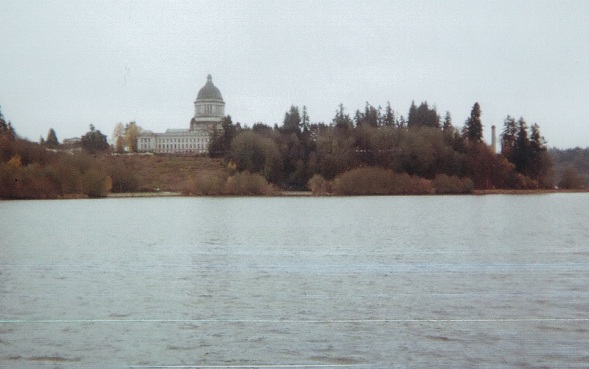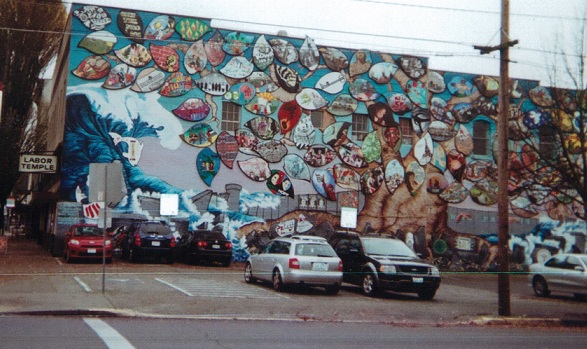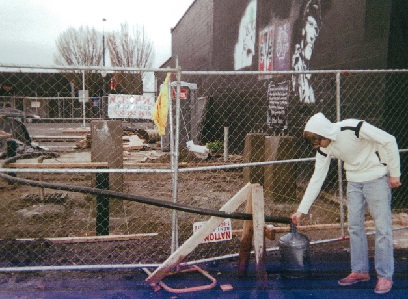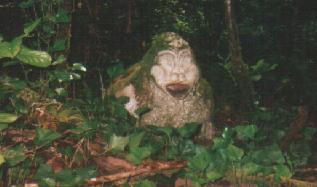
Let's see, where to begin? The waterfront? The West Bay is dominated by the wharf known as Percival Landing. From here, you can "look down on" the pleasure craft of the local gentry, but forget about going down there unless you know one of the owners. For a number of years, a prominent feature of this area was the houseboat Snog, an example of the true Vagabond style; unfortunately, it sank in February 1998. (If anyone has a picture, I would love to put it here, crediting you as the source; email me.) Just a few block south of Percival Landing, though, one finds more interesting places, including Traditions Cafe on 5th Avenue. More than just a cafe, Traditions also sells folk art from around the world, operating on the principle that the artisans deserve a fair price for their work. In the cafe section is also a small stage for the use of visiting performers; the space is not just for entertainment, but also for public addresses.
Next door to Traditions is the recreational fountain: a circle of smooth pavement, from which, in summer, numerous jets of water shoot upwards in unpredictable sequence. Children and families play here in warm weather. The fountain is closed for maintenance on Wednesdays. Just across 5th Avenue is Capitol Lake, above which looms the capitol building. The waters of the lake are closed to recreation, but there is a perimeter path, and the lakeside Heritage Park.
 This park has now entered history, as it was the site of the Occupy Olympia tent city after they were evicted from Sylvester Park. Follow the lakeshore around to the east (clockwise), and you will come to the winding path up through the gardens to the capitol building. Whenever the legislature is in session, couriers in red blazers run to and fro from building to building. The repairs from the earthquake of 2001 have been completed, and the Rotunda is now reopened. Around the square base of the dome is stonework in the shape of buffalo skulls, rather incongruous in this lush, green region, an allusion to the state's drier east side; the skulls are visible only from a few vantage points, the best of which is the porch of the Pritchard Library -- which has been gutted of its bookshelves in the wake of the earthquake. Only the Washington Room, in the basement, remains open. The rest of the library has been moved to Tumwater. And the Library is not the only disappearance; coming up from the lake, you will pass the empty shell of the conservatory, once a greenhouse displaying tropical plants, now empty and closed. Apparently, the Government feels that taking away the good things like the conservatory, and charging for parking, will somehow benefit the city. Be that as it may, the Capitol itself is still open for tours, for the traveler interested in the things of the State. States love propagandistic symbolism, and Washington is no exception. The outer skin of the Capitol is local Thurston County limestone; the Rotunda is marble from Alaska; and the inner chambers are three different marbles from Europe. Looking further afield the further in one goes -- surely there is some message there. And of course, though no actual nature is to be seen within those cold, stone walls, the reminders of it are there, underfoot: images of local flowers, the Western trillium in the House Chamber, Pacific dogwood in the Senate. But really, who can stand to stay long in the presence of the edifices of State power? Let us move on.
This park has now entered history, as it was the site of the Occupy Olympia tent city after they were evicted from Sylvester Park. Follow the lakeshore around to the east (clockwise), and you will come to the winding path up through the gardens to the capitol building. Whenever the legislature is in session, couriers in red blazers run to and fro from building to building. The repairs from the earthquake of 2001 have been completed, and the Rotunda is now reopened. Around the square base of the dome is stonework in the shape of buffalo skulls, rather incongruous in this lush, green region, an allusion to the state's drier east side; the skulls are visible only from a few vantage points, the best of which is the porch of the Pritchard Library -- which has been gutted of its bookshelves in the wake of the earthquake. Only the Washington Room, in the basement, remains open. The rest of the library has been moved to Tumwater. And the Library is not the only disappearance; coming up from the lake, you will pass the empty shell of the conservatory, once a greenhouse displaying tropical plants, now empty and closed. Apparently, the Government feels that taking away the good things like the conservatory, and charging for parking, will somehow benefit the city. Be that as it may, the Capitol itself is still open for tours, for the traveler interested in the things of the State. States love propagandistic symbolism, and Washington is no exception. The outer skin of the Capitol is local Thurston County limestone; the Rotunda is marble from Alaska; and the inner chambers are three different marbles from Europe. Looking further afield the further in one goes -- surely there is some message there. And of course, though no actual nature is to be seen within those cold, stone walls, the reminders of it are there, underfoot: images of local flowers, the Western trillium in the House Chamber, Pacific dogwood in the Senate. But really, who can stand to stay long in the presence of the edifices of State power? Let us move on.
Just outside the Capitol complex is United Churches of Olympia, which boldly displays a banner with a picture of a rainbow flag, showing that they welcome everyone. Now that Washington has legalized same-sex marriage, let us hope other churches will come around, too.
Or, try going east from Percival Landing. The Olympia Farmers' Market is one of the few places one can actually park; but of course, only while shopping at the market. In winter, one will find it quite deserted, but from April to December, local farmers and craftspeople gather here to sell their produce and handiwork. It is always worth a look around.
 South of the Farmers' Market and east of the fountain is the heart of the commercial district. Olympia has long been culturally influenced by the liberal-arts college, so you will also find herbalists, quirky bookstores, and various New Agey-type establishments. There are lots of murals here, some of them in the category of fine art, others folk art. Olympia must surely be one of the most artistic of cities, if the sheer number of murals is any indication. This one, on the Labor Temple, was made in honor of Olympia's "sister city," Rafah, in Gaza; there is a strong undercurrent of solidarity with the Palestinian people, and honor for the memory of local student Rachael Corrie, killed in Gaza by an Israeli weaponized bulldozer while trying to protect Palestinian homes. Many other murals hide on the sides of buildings or in alleyways, inviting exploration; one can scarcely walk two blocks in some sections without seeing a mural or several. Olympia truly deserves to be called "City of Murals."
South of the Farmers' Market and east of the fountain is the heart of the commercial district. Olympia has long been culturally influenced by the liberal-arts college, so you will also find herbalists, quirky bookstores, and various New Agey-type establishments. There are lots of murals here, some of them in the category of fine art, others folk art. Olympia must surely be one of the most artistic of cities, if the sheer number of murals is any indication. This one, on the Labor Temple, was made in honor of Olympia's "sister city," Rafah, in Gaza; there is a strong undercurrent of solidarity with the Palestinian people, and honor for the memory of local student Rachael Corrie, killed in Gaza by an Israeli weaponized bulldozer while trying to protect Palestinian homes. Many other murals hide on the sides of buildings or in alleyways, inviting exploration; one can scarcely walk two blocks in some sections without seeing a mural or several. Olympia truly deserves to be called "City of Murals."
Foodies will rejoice in the diversity of the scene. For one thing, there seems almost no end to the Thai restaurants. Never have I seen so many Thai restaurants in one city -- including two next door to each other in the same building! Vietnamese retaurants abound also; standing at Percival Landing, one can look east and see the Mini Saigon, or face south and see the Little Da Nang, and there are more besides, all in walking distance of each other. One of the newest arrivals on the Olympia food scene, though, is a food truck, currently parked at the corner of 4th and Plum: Nineveh, serving Assyrian foods. Of course, this being the Pacific Northwest, there are plenty of coffeehouses, too -- and as every Northwesterner knows, Starbucks is only for outsiders!
|
 Unique, though, is the artesian well --pure artesian water in the heart of the city, free for the taking. Just bring your containers. Local legend says that one who drinks of this water will surely return to Olympia. It worked in my case; I keep trying to leave, but somehow, I keep ending up in Olympia again and again. The well has had a major makeover recently. Originally, in a parking lot much like any other, a steel pipe rose from the pavement, bent into an upside-down "L," from which water flows without ceasing (there being no shutoff valve). This picture was taken during the renovation; a hose allowed people still to collect water while the site was fenced off. Note, once again, the murals, depicting members of the community who used the well. Now that renovations are complete, the cement pillars are covered with colored tiles; but the murals were painted over, reduced to a plain black wall. Why? But the people made their statement: the plain black wall where the murals once were has now been tagged with grafitti -- an appropriate protest against the destruction of public art by the city.
Unique, though, is the artesian well --pure artesian water in the heart of the city, free for the taking. Just bring your containers. Local legend says that one who drinks of this water will surely return to Olympia. It worked in my case; I keep trying to leave, but somehow, I keep ending up in Olympia again and again. The well has had a major makeover recently. Originally, in a parking lot much like any other, a steel pipe rose from the pavement, bent into an upside-down "L," from which water flows without ceasing (there being no shutoff valve). This picture was taken during the renovation; a hose allowed people still to collect water while the site was fenced off. Note, once again, the murals, depicting members of the community who used the well. Now that renovations are complete, the cement pillars are covered with colored tiles; but the murals were painted over, reduced to a plain black wall. Why? But the people made their statement: the plain black wall where the murals once were has now been tagged with grafitti -- an appropriate protest against the destruction of public art by the city.
 A short walk from the well is Capitol Theatre, which shows both independent films and live performances, and was the setting for the gathering featured in my essay, What Democracy Looks Like; note, once again, the murals, and the ever-present demand to pay for parking.
A short walk from the well is Capitol Theatre, which shows both independent films and live performances, and was the setting for the gathering featured in my essay, What Democracy Looks Like; note, once again, the murals, and the ever-present demand to pay for parking.
So long as we are downtown, we must of course stop in at Last Word Books. More than just another secondhand bookstore, Last Word also has an in-house press, publishing booklets and tracts on anarchist theory and other concerns of the resistance. Also, in the back, is the Olympia Zine Library, where numerous zines, otherwise difficult or impossible to find, are archived. Here we see Freedom of the Press in action; for those of us whose reading material differs from what commercial publishing houses will print, the alternative media are often our only option.
From Intercity Transit, buses run to the Westside. At the corner of Rogers Street and Giles Avenue stands the Olympia Food Co-op (there is also an Eastside location, on Pacific Avenue), where one can restock one's food supply. Much of what is sold here is organic and/or locally grown or made. Outside the co-op is the "Free Store," where anyone may put in or take out used clothing, as needed. In the Eastside location is also T.U.L.I.P., that is, the Thurston Union for Low-Income People -- now that the corporate banks have so disgraced themselves in the recent economic crisis, credit unions are seeing an upsurge in popularity, and here we have one oriented specifically to those who could never hope to get a loan from a corporate bank.
 The main destination on the Westside, though, is The Evergreen State College, with a welcome figure of a drummer carved in cedar at the main street entrance. At various places around the campus are murals and sculpture, although this startling forest goblin has disappeared. Even so, there is plenty of public art to be found, both indoors and out -- the campus is almost as full of art as downtown. There is an extensive library; reference is on the main floor, periodicals and circulating books on the upper floor. They claim to be one of the few academic libraries open to the general public. The entire building is known as the Library, even though the actual library occupies only part of one wing; it features a prominent clock tower. The tower is part of the campus ventilation system: just below the clock faces is an air intake vent, from which air blows down inside the hollow tower. The tower's basement feels like a wind tunnel, and is connected to a series of underground passages connecting the buildings. Square brick platforms rise from the earth in at least two places, providing further ventilation for the underground passages. The other end of the tunnel opens into the onsite power plant with two small cooling towers. The tunnels are conduits for electrical cables, water pipes, and steam ducts. Other keynote features around campus are the onsite Organic Farm; the Longhouse inspired by the Native American Studies program; and the new Seminar II Building, featuring a "green" roof and other "green" design elements.
The main destination on the Westside, though, is The Evergreen State College, with a welcome figure of a drummer carved in cedar at the main street entrance. At various places around the campus are murals and sculpture, although this startling forest goblin has disappeared. Even so, there is plenty of public art to be found, both indoors and out -- the campus is almost as full of art as downtown. There is an extensive library; reference is on the main floor, periodicals and circulating books on the upper floor. They claim to be one of the few academic libraries open to the general public. The entire building is known as the Library, even though the actual library occupies only part of one wing; it features a prominent clock tower. The tower is part of the campus ventilation system: just below the clock faces is an air intake vent, from which air blows down inside the hollow tower. The tower's basement feels like a wind tunnel, and is connected to a series of underground passages connecting the buildings. Square brick platforms rise from the earth in at least two places, providing further ventilation for the underground passages. The other end of the tunnel opens into the onsite power plant with two small cooling towers. The tunnels are conduits for electrical cables, water pipes, and steam ducts. Other keynote features around campus are the onsite Organic Farm; the Longhouse inspired by the Native American Studies program; and the new Seminar II Building, featuring a "green" roof and other "green" design elements.
The central campus carries some (humorous?) historical allusions: the plaza paved with red brick is known as Red Square, while the mound at the street entrance, just behind the welcome figure, is referred to as the Grassy Knoll. On Red Square is a plaque marking the North Star Viewing Spot (it probably only works at night). During the growing season, students from the on-campus organic farm will have a table just outside the Library building, selling whatever produce is in season.
Scattered around campus are various bulletin boards, carrying notices about protests, solidarity events, and activist organizations. There is also free distribution of the environmental newspaper, South Sound Green Pages, and the civil-rights newspaper, Works in Progress, as well as Berkeley-based anarchist newspaper, Slingshot. Somewhere on campus (I have never figured out where), KAOS Radio broadcasts -- world, indie, and local music, Democracy Now's War and Peace Report, Workers Independent News, programming of interest to social justice and civil liberties, and the community bulletin board.
And what of Evergreen's notorious Geoduck Beach? A sign at the entrance states that the beach is open only to students, faculty, and staff; and before it was vandalized, it also said, "no nudity." Its nude use was therefore always unsanctioned, and lately, campus police have been enforcing the policy. Even so, it will likely remain a de facto nude beach anyway -- the po-po can't be everywhere at once. And even if they do manage to quash the nude beach, there are areas in the extensive campus woods where one could strip down unnoticed; I once even came upon the remains of a squatter's shack, smashed under a fallen tree, with most of the erstwhile occupant's belongings still there -- so it is possible to live "under the radar." With Seattle now on my blacklist thanks to the WTO snafu (see my essay, What Democracy Looks Like), Olympia will do nicely for me.
HOME |

 Unique, though, is the artesian well --pure artesian water in the heart of the city, free for the taking. Just bring your containers. Local legend says that one who drinks of this water will surely return to Olympia. It worked in my case; I keep trying to leave, but somehow, I keep ending up in Olympia again and again. The well has had a major makeover recently. Originally, in a parking lot much like any other, a steel pipe rose from the pavement, bent into an upside-down "L," from which water flows without ceasing (there being no shutoff valve). This picture was taken during the renovation; a hose allowed people still to collect water while the site was fenced off. Note, once again, the murals, depicting members of the community who used the well. Now that renovations are complete, the cement pillars are covered with colored tiles; but the murals were painted over, reduced to a plain black wall. Why? But the people made their statement: the plain black wall where the murals once were has now been tagged with grafitti -- an appropriate protest against the destruction of public art by the city.
Unique, though, is the artesian well --pure artesian water in the heart of the city, free for the taking. Just bring your containers. Local legend says that one who drinks of this water will surely return to Olympia. It worked in my case; I keep trying to leave, but somehow, I keep ending up in Olympia again and again. The well has had a major makeover recently. Originally, in a parking lot much like any other, a steel pipe rose from the pavement, bent into an upside-down "L," from which water flows without ceasing (there being no shutoff valve). This picture was taken during the renovation; a hose allowed people still to collect water while the site was fenced off. Note, once again, the murals, depicting members of the community who used the well. Now that renovations are complete, the cement pillars are covered with colored tiles; but the murals were painted over, reduced to a plain black wall. Why? But the people made their statement: the plain black wall where the murals once were has now been tagged with grafitti -- an appropriate protest against the destruction of public art by the city. A short walk from the well is Capitol Theatre, which shows both independent films and live performances, and was the setting for the gathering featured in my essay, What Democracy Looks Like; note, once again, the murals, and the ever-present demand to pay for parking.
A short walk from the well is Capitol Theatre, which shows both independent films and live performances, and was the setting for the gathering featured in my essay, What Democracy Looks Like; note, once again, the murals, and the ever-present demand to pay for parking.